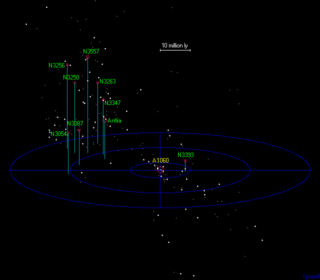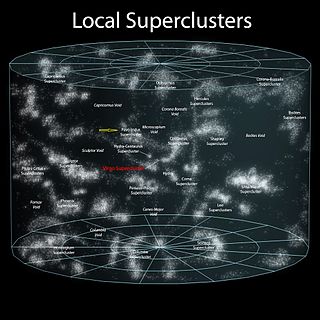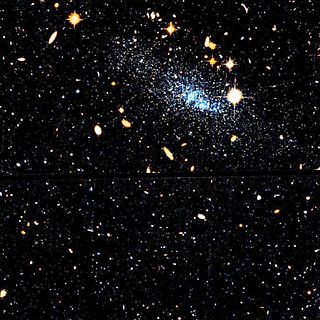
The Local Group is the galaxy group that includes the Milky Way, where Earth is located. It has a total diameter of roughly 3 megaparsecs (10 million light-years; 9×1019 kilometres), and a total mass of the order of 2×1012 solar masses (4×1042 kg). It consists of two collections of galaxies in a "dumbbell" shape; the Milky Way and its satellites form one lobe, and the Andromeda Galaxy and its satellites constitute the other. The two collections are separated by about 800 kiloparsecs (3×10^6 ly; 2×1019 km) and are moving toward one another with a velocity of 123 km/s. The group itself is a part of the larger Virgo Supercluster, which may be a part of the Laniakea Supercluster. The exact number of galaxies in the Local Group is unknown as some are occluded by the Milky Way; however, at least 80 members are known, most of which are dwarf galaxies.

Pisces is a constellation of the zodiac. Its vast bulk – and main asterism viewed in most European cultures per Greco-Roman antiquity as a distant pair of fishes connected by one cord each that join at an apex – are in the Northern celestial hemisphere. Its old astronomical symbol is (♓︎). Its name is Latin for "fishes". It is between Aquarius, of similar size, to the southwest and Aries, which is smaller, to the east. The ecliptic and the celestial equator intersect within this constellation and in Virgo. This means the sun passes directly overhead of the equator, on average, at approximately this point in the sky, at the March equinox.

The Sagittarius Dwarf Spheroidal Galaxy (Sgr dSph), also known as the Sagittarius Dwarf Elliptical Galaxy, is an elliptical loop-shaped satellite galaxy of the Milky Way. It contains four globular clusters in its main body, with the brightest of them—NGC 6715 (M54)—being known well before the discovery of the galaxy itself in 1994. Sgr dSph is roughly 10,000 light-years in diameter, and is currently about 70,000 light-years from Earth, travelling in a polar orbit at a distance of about 50,000 light-years from the core of the Milky Way. In its looping, spiraling path, it has passed through the plane of the Milky Way several times in the past. In 2018 the Gaia project of the European Space Agency showed that Sgr dSph had caused perturbations in a set of stars near the Milky Way's core, causing unexpected rippling movements of the stars triggered when it moved past the Milky Way between 300 and 900 million years ago.

The Hydra–Centaurus Supercluster, or the Hydra and Centaurus Superclusters, was a previously defined supercluster in two parts, which prior to the identification of Laniakea Supercluster in 2014 is the closest neighbour of the former Virgo Supercluster. Its center is located about 39 Mpc (127 Mly) away.

A dwarf galaxy is a small galaxy composed of about 1000 up to several billion stars, as compared to the Milky Way's 200–400 billion stars. The Large Magellanic Cloud, which closely orbits the Milky Way and contains over 30 billion stars, is sometimes classified as a dwarf galaxy; others consider it a full-fledged galaxy. Dwarf galaxies' formation and activity are thought to be heavily influenced by interactions with larger galaxies. Astronomers identify numerous types of dwarf galaxies, based on their shape and composition.

The Pisces Dwarf, also known as Pisces I, is an irregular dwarf galaxy that is part of the Local Group. The galaxy, taking its name from the constellation Pisces where it appears, is suspected of being a satellite galaxy of the Triangulum Galaxy (M33). It displays a blueshift, as it is approaching the Milky Way at 287 km/s. It may be transition-type galaxy, somewhere between dwarf spheroidal and dwarf irregular. Alternatively, it may be a rare, but statistically acceptable, version of one of the two types.

A satellite galaxy is a smaller companion galaxy that travels on bound orbits within the gravitational potential of a more massive and luminous host galaxy. Satellite galaxies and their constituents are bound to their host galaxy, in the same way that planets within our own solar system are gravitationally bound to the Sun. While most satellite galaxies are dwarf galaxies, satellite galaxies of large galaxy clusters can be much more massive. The Milky Way is orbited by about fifty satellite galaxies, the largest of which is the Large Magellanic Cloud.
Canes Venatici I or CVn I is a dwarf spheroidal galaxy situated in the Canes Venatici constellation and discovered in 2006 in the data obtained by Sloan Digital Sky Survey. It is one of the most distant known satellites of the Milky Way as of 2011 together with Leo I and Leo II. The galaxy is located at a distance of about 220 kpc from the Sun and is moving away from the Sun at a velocity of about 31 km/s. It is classified as a dwarf spheroidal galaxy (dSph) meaning that it has an elliptical shape with the half-light radius of about 550 pc.

The Pavo–Indus Supercluster is a neighboring supercluster located about 60–70 Mpc (196–228 Mly) away in the constellations of Pavo, Indus, and Telescopium. The supercluster contains three main clusters, Abell 3656, Abell 3698, and Abell 3742.
Segue 1 is a dwarf spheroidal galaxy or globular cluster situated in the Leo constellation and discovered in 2006 by Sloan Digital Sky Survey. It is located at a distance of about 23 kpc from the Sun and moves away from the Sun with the velocity of about 206 km/s. Segue 1 has a noticeably elongated shape with the half-light radius of about 30 pc. This elongation may be caused by the tidal forces acting from the Milky Way galaxy if Segue 1 is being tidally disrupted now.

The Local Void is a vast, empty region of space, lying adjacent to the Local Group. Discovered by Brent Tully and Rick Fisher in 1987, the Local Void is now known to be composed of three separate sectors, separated by bridges of "wispy filaments". The precise extent of the void is unknown, but it is at least 45 Mpc across, and possibly 150 to 300 Mpc. The Local Void appears to have significantly fewer galaxies than expected from standard cosmology.
Coma Berenices or Com is a dwarf spheroidal galaxy situated in the Coma Berenices constellation and discovered in 2006 in data obtained by the Sloan Digital Sky Survey. The galaxy is located at the distance of about 44 kpc from the Sun and moves away from the Sun with the velocity of about 98 km/s. It is classified as a dwarf spheroidal galaxy (dSph) meaning that it has an elliptical shape with the half-light radius of about 70 pc.

Hercules, or Her, is a dwarf spheroidal galaxy situated in the Hercules constellation and discovered in 2006 in data obtained by the Sloan Digital Sky Survey. The galaxy is located at a distance of about 140 kpc from the Sun and moves away from the Sun with a velocity of about 45 km/s. It is classified as a dwarf spheroidal galaxy (dSph). It has a noticeably elongated shape with a half-light radius of about 350 pc. This elongation may be caused by tidal forces acting from the Milky Way galaxy, meaning that Her is being tidally disrupted now. Her also shows some gradient of velocities across the galaxy's body and is embedded into a faint stellar stream, which also points towards its ongoing tidal disruption.
Pisces II is a dwarf spheroidal galaxy situated in the Pisces constellation and discovered in 2010 in the data obtained by the Sloan Digital Sky Survey. The galaxy is located at the distance of about 180 kpc (kiloparsecs) from the Sun. It is classified as a dwarf spheroidal galaxy (dSph) meaning that it has an elongated shape with the half-light radius of about 60 pc and ratio of the axis of about 5:3.
Andromeda XIX is a satellite galaxy of the Andromeda Galaxy (M31), a member of the Local Group, like the Milky Way Galaxy. Andromeda XIX is considered "the most extended dwarf galaxy known in the Local Group", and has been shown to have a half-light radius of 1.7 kiloparsec (kpc). It was discovered by the Canada–France–Hawaii Telescope, and is thought to be a dwarf galaxy.

Pisces B is a void dwarf galaxy. It is located in the Local Void, near Pisces A; and is in the Pisces constellation. It is 30 million light-years away from the Earth. The galaxy was discovered with the WIYN Observatory. About 100 million years ago, the galaxy started moving out of the void and into the local filament zone and denser gaseous environment. This sparked off a doubling of the rate of star formation.

NGC 536 is a barred spiral galaxy located in the constellation Andromeda. It is located at a distance of circa 200 million light-years from Earth, which, given its apparent dimensions, means that NGC 536 is about 180,000 light years across. It was discovered by William Herschel on September 13, 1784. It is a member of Hickson Compact Group 10, which also includes the galaxies NGC 529, NGC 531, and NGC 542. It belongs to the Perseus–Pisces Supercluster.

Leo P is a small, star-forming irregular galaxy located in the constellation Leo, discovered through the blind HI Arecibo Legacy Fast ALFA (ALFALFA) survey, as an ultra-compact high-velocity cloud (UCHVC) of hydrogen gas. Its confirmation as a dwarf galaxy in 2013 suggests that other such UCHVCs are possibly undiscovered dwarf galaxies themselves. Leo P is noteworthy for harbouring one of the most metal-poor environments in the local universe. Its metallicity is just 3% that of the Sun's, meaning that its stars contain 30 times less heavy elements than the Sun. This makes Leo P similar to the pristine environments of primordial galaxies.













